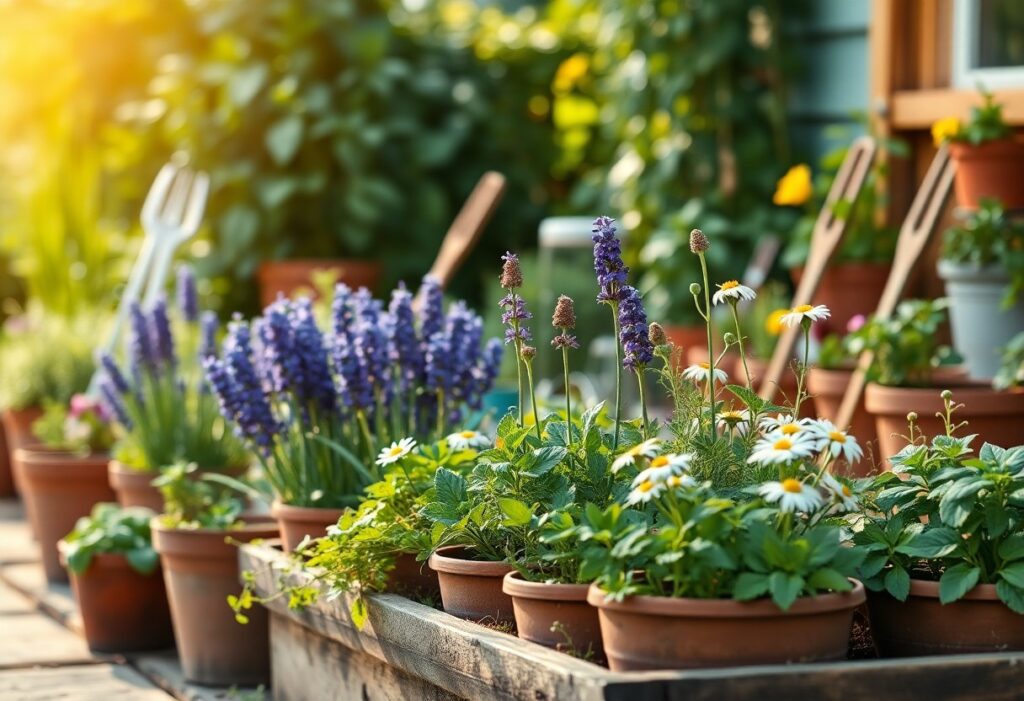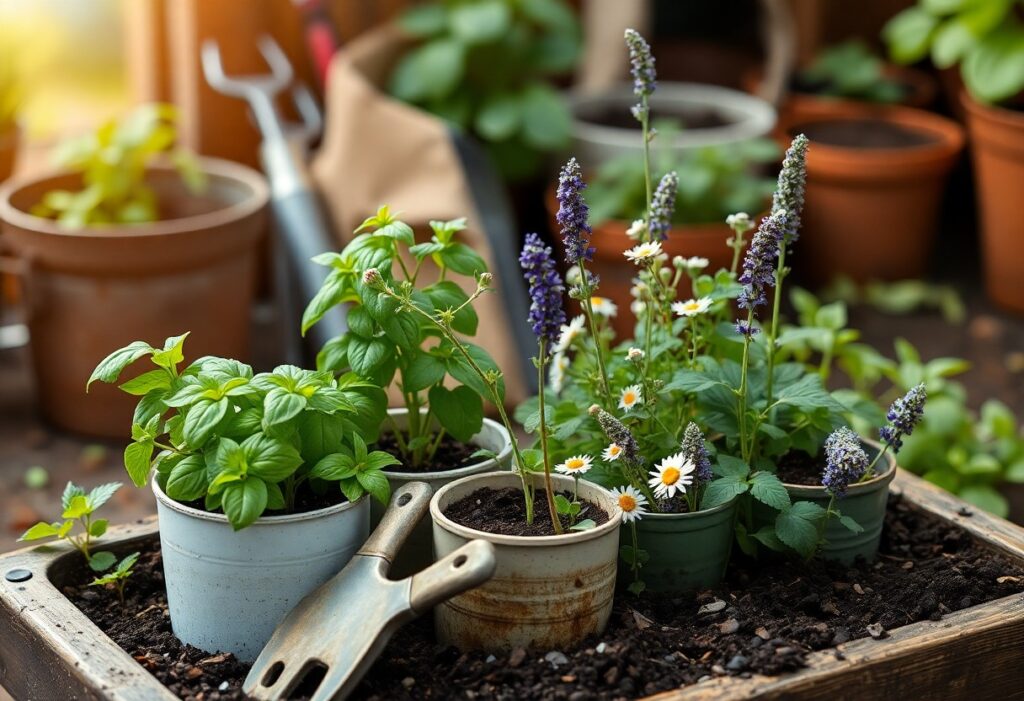You might be excited about creating your own home medicinal garden, but without the right tools, your journey could become tedious. In this guide, I will share the necessary tools that will not only make gardening easier but also enhance your experience growing healing herbs. From soil preparation to harvesting, equipping yourself with these must-have instruments ensures you cultivate a thriving garden that supports your health and well-being. Let’s look into the tools you need to succeed and make the most of your medicinal plants!
Key Takeaways:
- Quality Soil: Invest in nutrient-rich, well-draining soil to support healthy plant growth in your garden.
- Gardening Tools: Essential tools like trowels, pruners, and hoe enhance efficiency and ease during planting and maintenance.
- Watering System: Proper irrigation, whether through hoses or drip systems, is vital for keeping your medicinal plants hydrated.
- Plant Markers: Use clear labels or markers to identify different herbs and plants for easy care management.
- Pest Control Solutions: Natural pest deterrents and organic solutions help protect your garden without harmful chemicals.
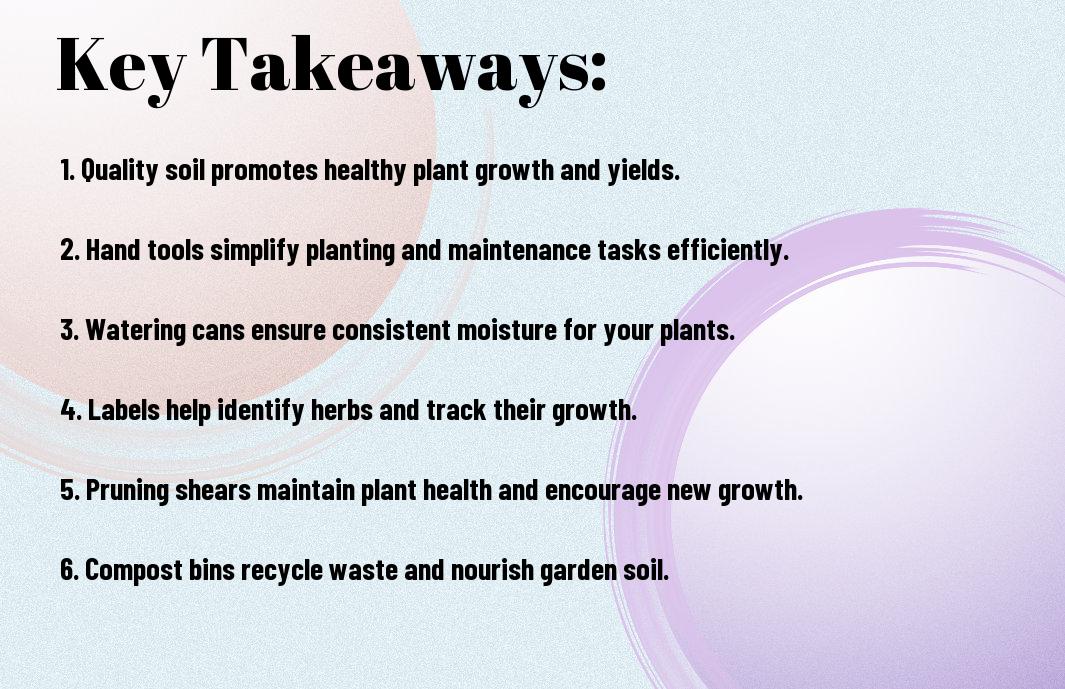
Essential Gardening Tools
The right tools can significantly enhance your gardening experience, especially when it comes to cultivating your medicinal garden. In this section, I’ll share the important gardening tools that can make your gardening tasks easier and more efficient. From hand tools that allow for precise work to power tools that save time and effort, understanding what you need is vital to achieving success in your garden.
Hand Tools
One of the most important aspects of tending to your medicinal garden is having the right hand tools at your disposal. Basic hand tools such as trowels, hand cultivators, and pruners are indispensable in achieving precision in planting and maintenance. I always make sure to invest in high-quality tools that feel comfortable in my hands, as this not only makes gardening easier but also more enjoyable. A sturdy pair of gloves is also important to protect your hands while working with dirt and plants.
Power Tools
Among the various tools I use, power tools can truly make a significant difference in the efficiency of your gardening tasks. Tools like electric tillers or string trimmers can help you break up tough soil and maintain clean edges around your garden pathways effortlessly. When you’re working on larger plots of land, these tools can save you a lot of time and physical strain, allowing you to focus more on the nurturing aspects of your plants.
Understanding the type of power tools suitable for your garden setup is important, as it can lead to a safer and more productive gardening experience. For starters, you should consider using tools with safety features to avoid accidents while you work. Also, opting for battery-powered tools can be a less hazardous choice when it comes to managing cords and fuel. Investing in high-quality power tools is a positive step that can enhance your gardening routine, making it less labor-intensive while promoting healthy growth in your medicinal plants.
Soil Preparation Equipment
Any gardener knows that the foundation of a thriving home medicinal garden is the soil. Proper soil preparation is important for growing healthy plants that can provide you with the remedies you seek. The right tools can make the process smoother and ensure that your garden flourishes. Investing in soil preparation equipment is not just about having the right tools; it’s about creating an environment that maximizes plant health and growth potential.
Soil Test Kits
At the heart of successful soil preparation lies understanding your soil’s composition. Soil test kits are vital tools that allow you to gauge nutrient levels, pH balance, and the presence of any harmful contaminants. By analyzing your soil, you can make informed decisions about amendments you might need, such as adding lime to correct acidity or incorporating organic matter to boost fertility. I often find that a simple test can save countless hours of trial and error in trying to grow medicinal plants.
Tillers and Hoes
After assessing your soil with a test kit, it’s time to break ground. Tillers and hoes come into play here, helping to prepare the soil for planting. Tillers can effectively aerate compact soil, allowing for better water penetration and root development, while hoes are great for cultivating the soil surface and removing weeds. I personally prefer using a manual hoe for smaller gardens, as it allows for more control and precision in my planting beds.
Preparation is key when it comes to using tillers and hoes in your home garden. A tiller can streamline the soil aeration process, especially if you have larger plots, but I always advise using it at the right depth to avoid disrupting any beneficial organisms. Hoes, on the other hand, allow you to maintain more control over the soil texture and eliminate weeds that might compete with your medicinal plants for nutrients. Each tool has its strengths, so take the time to familiarize yourself with how they can best serve your garden needs.
Watering Tools
Now that you’ve established your home medicinal garden, having the right watering tools is necessary for promoting healthy plant growth. Watering your plants adequately ensures they receive the necessary nutrients to thrive, and one of the best ways to automate this process is through irrigation systems. By investing in an irrigation system, you can set it to provide consistent moisture to your garden without the need for daily manual watering. This is particularly useful if you have a larger garden or if you plan to be away for extended periods. The system can be efficiently programmed to deliver water during optimal times, minimizing evaporation and water waste.
Irrigation Systems
Above all, there are various types of irrigation systems available, each catering to different needs. Drip irrigation systems, for instance, deliver precise amounts of water directly to the roots of your plants, allowing for minimal waste and maximum efficiency. This method is excellent for medicinal herbs and plants that require specific moisture levels. Alternatively, soaker hoses can also provide a consistent moisture supply and are easy to install and maintain, making them a convenient choice for those just starting with their home garden.
Garden Hoses and Sprinklers
Against the backdrop of irrigation systems, using traditional garden hoses and sprinklers is another effective way to water your medicinal garden. A quality garden hose is indispensable; it allows you to cover all areas of your garden without hassle. With adjustable nozzles and lightweight materials, you can direct the water flow precisely where you need it, ensuring that every corner of your garden receives the attention it deserves.
Tools like garden hoses and sprinklers offer versatility in watering your medicinal garden. Whether you prefer a standard garden hose that you can maneuver around or a sprinkler system for larger areas, both options have significant benefits. The ability to control water flow ensures that your plants won’t be overwatered, which can lead to root rot. Additionally, using timers on your hose or sprinkler can automate the process, allowing you to focus on other necessary tasks in your garden while ensuring that your plants remain hydrated.
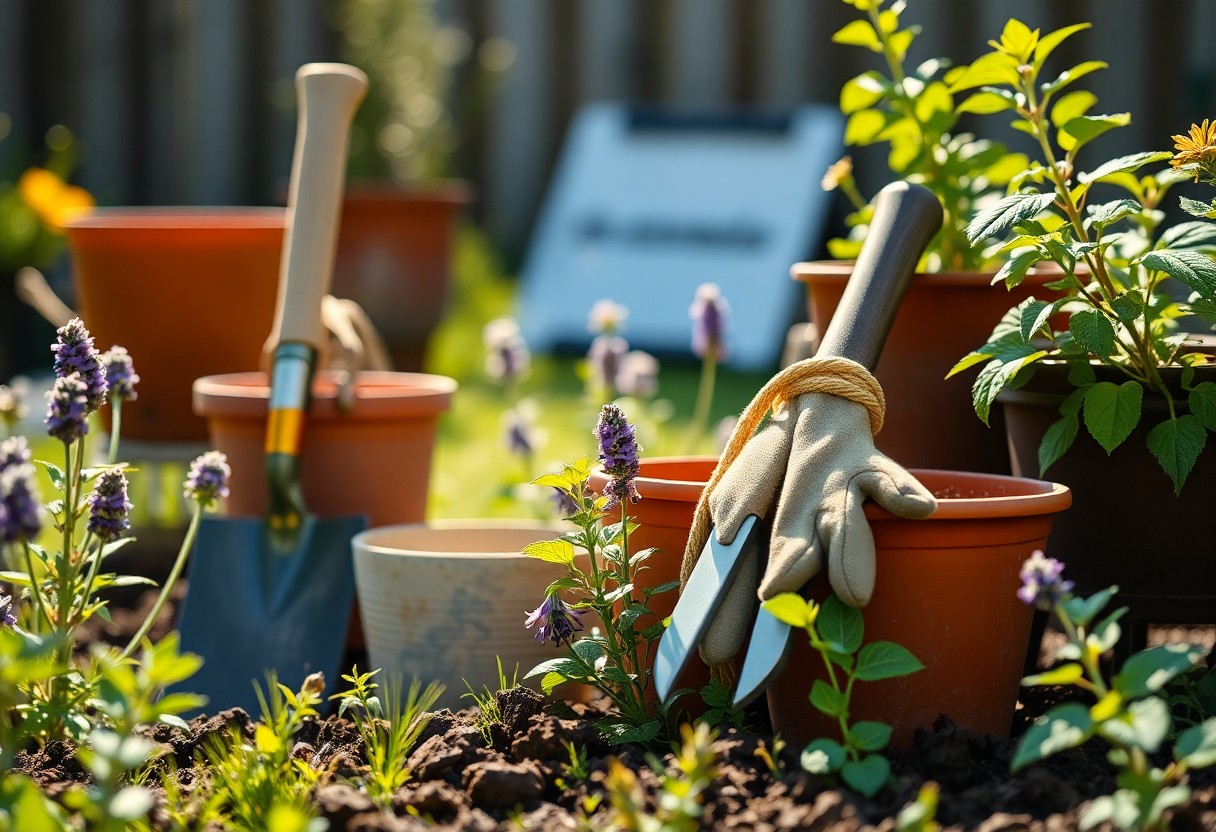
Pest Management Tools
Unlike the average garden, a home medicinal garden requires careful pest management tools to ensure that your plants remain healthy and productive. I have discovered that a combination of preventive measures and strategic interventions can keep your plants free from damaging pests, allowing you to grow the herbs and medicines you need without harmful chemicals. By integrating these tools into your gardening routine, you can create a thriving and sustainable environment for your plants.
Natural Pest Control Alternatives
Between the many options available for pest control, natural alternatives provide a safer and environmentally friendly approach. Plant companions, such as marigolds and basil, not only enhance the flavor of your medicinal herbs but also deter pests naturally. Additionally, I often use homemade solutions, like neem oil or a soap and water mixture, as they are effective in managing insect populations without introducing harsh chemicals into my garden. Utilizing natural pest repellents ensures that the integrity of my medicinal plants remains intact while promoting biodiversity in my garden.
Application Equipment
For effective pest management, having the right application equipment is important. I find that using sprayers, whether handheld or garden-sized, allows me to deliver my natural pest control solutions evenly and efficiently. Additionally, I rely on traps and barriers that are specifically designed to minimize pest damage without harming beneficial insects. Investing in quality equipment not only simplifies the application process but also enhances the overall effectiveness of pest management efforts in your medicinal garden.
To further improve the efficiency of your application, consider incorporating protective gear such as gloves, goggles, and masks when using any pest control products. This ensures your safety while applying treatments. Furthermore, it’s important to maintain your equipment regularly, as clean and well-functioning sprayers and traps will yield better results in controlling pests. I always aim for precision and care during application to safeguard my plants and maximize the potential of my medicinal garden.
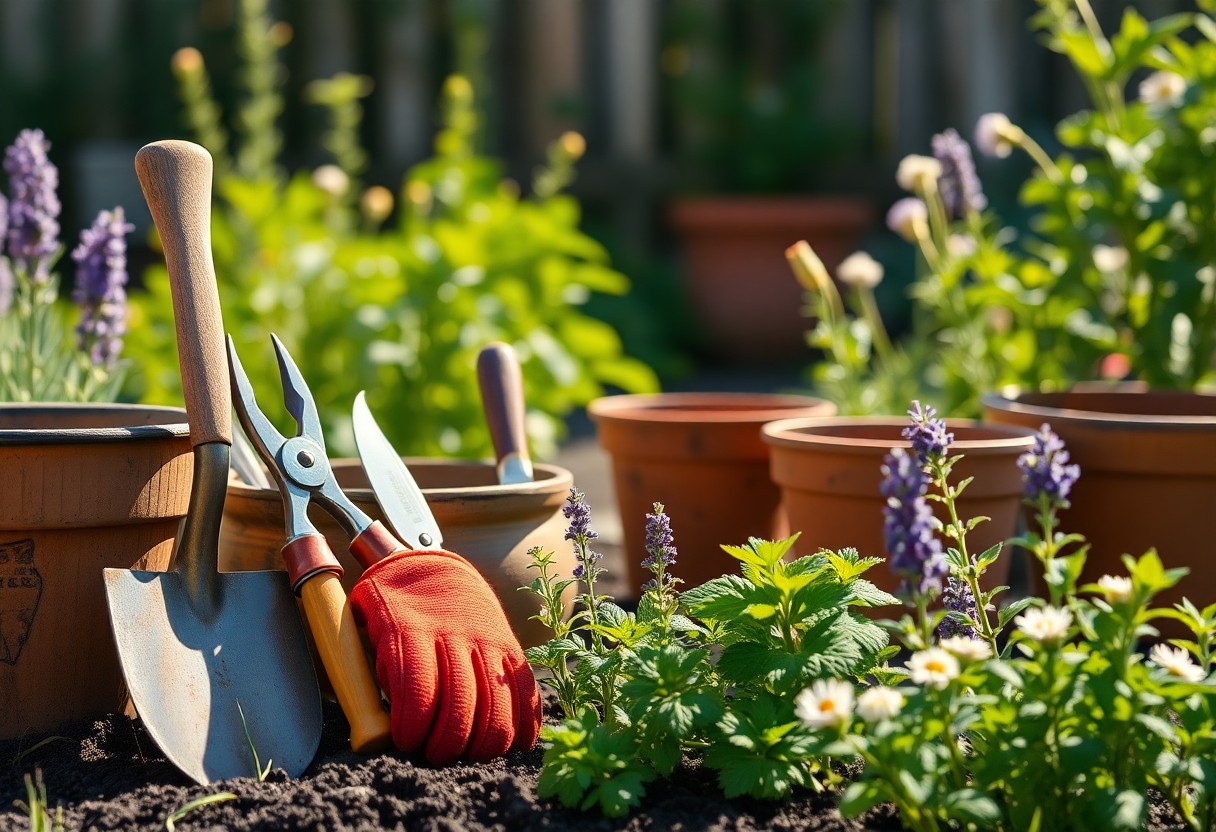
Harvesting Tools
For anyone looking to cultivate a home medicinal garden, having the right harvesting tools is just as necessary as planting the herbs and plants themselves. These tools not only make the task of gathering your plants easier but also help maintain the health of your garden. Properly harvested plants can improve both their shelf-life and effectiveness, so investing in quality equipment should not be overlooked.
Pruners and Shears
Pruners are an indispensable tool for any gardener. They allow you to trim and shape your plants, promoting healthy growth and ensuring you’re only harvesting the best parts. With a good pair of pruners, I can easily access even those hard-to-reach spots in my garden. It’s important to choose a pair that feels comfortable in your hands and is suitable for the specific types of herbs and plants you are tending to. Shears are similarly valuable for larger items or more extensive harvesting, giving you the precision and power needed to cut through tougher stems.
Harvesting Bags and Baskets
An efficient way to collect your herbs and plants is through the use of harvesting bags and baskets. These tools help you transport your harvest without causing damage to your delicate plants. I prefer using bags made from breathable materials that prevent moisture build-up, preserving the quality of my harvest. Baskets, on the other hand, are helpful for larger collections and provide better visibility of what’s inside, allowing me to ensure that I’m not inadvertently smashing anything during transport.
Plus, using harvesting bags and baskets can help organize your harvest process. With designated containers, you can separate different types of herbs, making it simpler to process or store them later. This enhances your efficiency in the garden and can even be a fun way to involve others in the harvesting process. By keeping things orderly and accessible, you increase your chances of enjoying a fruitful and successful season in your medicinal garden.
Storage and Preservation Tools
Not only do I find growing my medicinal garden fulfilling, but ensuring that my harvest is properly stored and preserved is equally important. The right tools play a significant role in maintaining the potency of your herbs and plants, helping you to take advantage of their healing properties long after the season’s end. One such necessary tool is a good set of drying racks, which allows for a steady airflow around your plants, enabling them to air dry effectively without compromising their quality.
Drying Racks
The use of drying racks is indispensable when it comes to preserving your herbs. These racks come in various designs, from multi-tiered hanging models to simple, flat surfaces, and they allow me to dry a variety of plants while maximizing space. By suspending your herbs above the ground, you minimize the risk of mold and mildew, which can ruin your hard work. Make sure to place your drying racks in a well-ventilated area away from direct sunlight, as this helps maintain the herbs’ vibrant colors and necessary oils.
Jars and Containers
An necessary component of my medicinal garden toolkit is a collection of appropriate jars and containers. Once your herbs are dried, transferring them to airtight glass jars is critical for preserving their flavor and potency. I find that glass not only provides a non-reactive storage solution but also allows me to visually assess the contents. I prefer using dark-colored jars, as they help block light exposure that can degrade the quality of the herbs over time.
In addition to glass jars, consider investing in specialized containers designed for long-term storage of medicinal herbs. Vacuum-sealed bags or oxygen absorbers can further prolong the life of your dried products, keeping them fresh and full of their natural therapeutic benefits. By labeling your jars with the name and date of each herb, you can easily keep track of your inventory and spot any potential spoilage, ensuring that you always have access to quality natural remedies at your fingertips.
Summing up
Summing up, as I reflect on the must-have tools for your home medicinal garden, it’s clear that having the right equipment can significantly enhance your gardening experience and ensure that your plants thrive. By investing in tools like a good-quality trowel, pruners, and a versatile watering system, you create an environment where your medicinal herbs can flourish. I believe that not only do these tools promote efficiency and ease, but they also help you cultivate a deeper connection with your garden, allowing you to fully appreciate the process of growing and caring for your plants.
Moreover, incorporating specialized tools, such as herb drying racks or garden labels, can streamline your gardening practices and keep your medicinal collection organized and accessible. As you launch on this rewarding journey of home gardening, equipping yourself with these necessary tools will empower you to create a thriving medicinal garden that not only meets your needs but also enriches your well-being. I encourage you to invest time in choosing the right tools to support your gardening aspirations and make the most of the healing nature of the plants you cultivate.
FAQ
Q: What basic tools do I need to start my home medicinal garden?
A: To start your home medicinal garden, you’ll need some imperative tools including a trowel for digging and transplanting, a hand rake for soil aeration, pruning shears for trimming plants, a watering can or hose for irrigation, and gardening gloves to protect your hands. These basic tools will help you manage your garden effectively.
Q: How can a soil test kit benefit my medicinal garden?
A: A soil test kit is beneficial as it provides valuable information about the nutrient levels and pH of your soil. By understanding these factors, you can amend your soil accordingly to create a healthy growing environment for your medicinal plants. This helps in optimizing plant health and maximizing the medicinal compounds produced.
Q: Why is a garden hoe important for medicinal gardening?
A: A garden hoe is important as it helps with weeding and tilling the soil. Regular weeding prevents competition for nutrients and water, which can hinder the growth of your medicinal plants. Tilling helps in aerating the soil and breaking up compacted areas, promoting healthy root development.
Q: Is it necessary to have a compost bin for my medicinal garden?
A: While not absolutely necessary, having a compost bin is highly beneficial for your medicinal garden. Compost enriches the soil with nutrients, improves soil structure, and enhances moisture retention. It also promotes the presence of beneficial microorganisms, which can improve pest resistance and plant health.
Q: What tools can help with pest control in my home medicinal garden?
A: Tools like insect nets, row covers, and traps can be effective in managing pests. Insect nets protect your plants from larger pests while allowing sunlight and rain to reach them. Row covers provide an extra layer of protection, while traps can help monitor and catch specific pests. Additionally, using organic insecticides or DIY pest repellents can further support pest management efforts.
